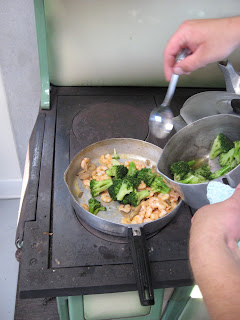Side note: I'm amused at how cooking on a wood burning cookstove gets in your blood and changes your thought processes. When I began to notice that the oven on the propane stove wasn't hot enough and knew that turning the dial resulted in nothing, I experienced a fleeting moment when my mind was instinctually wondering what small sticks or corn cobs I could put in the broiler drawer to get the oven hotter. Obviously, I didn't go so far as to try such an outrageous thing, but nonetheless, the thought most certainly crossed my mind before I was jolted back to reality by the cognizance that I could easily burn our house down by doing a thing like that.
At any rate, when Nancy suddenly remembered that she might need a pan of bars for our church's potato bake tomorrow, our only real options for accomplishing such a thing that had any sort of quality were to travel to either her folks' or my folks' houses and bake there or fire up the range in the summer kitchen. We had already been away from home twice today, so I wasn't too excited about going anywhere and therefore chose to build a fire out in the summer kitchen.
The last time that I cooked on a wood cookstove was for the family reunion in August. For me, this has been a long, long time. In fact, this is the longest I've been away from a cookstove in ten years, and I've just got to say that tonight's baking felt good. I trust that other wood cookstove enthusiasts out there will know exactly what I mean. Standing next to a wood cookstove that is hot enough to bake in just plain feels right to me. I probably can't even describe it adequately, but tonight while I was down in the summer kitchen working over the stove, it struck me that I feel like a stove ought to be a presence and a personality rather than a sterile, dead box. Even in the summer, when the heat of the cookstove literally drives me out of the summer kitchen, it seems like it still subconsciously feels right.
Anyway, enough with this waxing poetic. On to the recipe and pictures!
Tonight, I decided to make Rosalie's Spice Bars. Rosalie is a former neighbor and longtime family friend, and she is an excellent cook. Many recipes in my family's boxes bear her name. Generally, our family simply calls these "Raisin Bars" because the raisins are really more the star ingredient than the two teaspoons of cinnamon which constitute the only spice in the whole recipe.
I chose this recipe tonight because it makes a large batch of bars, but I consider it a good wood cookstove recipe because you have to parboil the raisins before baking the bars. I think that any recipe for something that starts with top-of-the-stove cooking but ends with baking is particularly well suited to the wood cookstove because it allows you to utilize the heat that the stove is emitting while you wait for the oven to heat.
Rosalie's Spice Bars
1 and 1/2 cups raisins parboiled
1 cup reserved raisin water
1 cup shortening at room temperature
1 1/2 cup white sugar
2 eggs
1 1/2 tsp. baking soda
1 tsp. vanilla
2 tsp. cinnamon
3 cups all-purpose flour
Cream the shortening and the sugar until fluffy. Beat in the eggs. Mix in the soda, vanilla, and cinnamon. Drain the raisins, reserving the one cup of liquid. Add the flour alternately with the hot raisin water. The dough will be kind of fluffy. Fold in the cooked raisins. Pour into a greased 12" x 17" jelly roll pan. Bake in a moderate oven until a fork inserted in the center tests done. Let cool and frost with caramel frosting or cream cheese frosting. We always use caramel frosting. I'll put that recipe in a later post.
 |
| The bars being put into the oven of the cookstove. We used the camera's flash in this picture and the next so that the color of the bars is visible. |
 |
| Golden brown doneness! You can see that they cooked very evenly. I turned them once after about fifteen minutes of baking. |
 |
| A view from the top so that you can see the texture. Obviously, a smaller pan would be a problem! |
They should be cool enough to frost now, so I'd better go take care of them. They will be delicious!














































